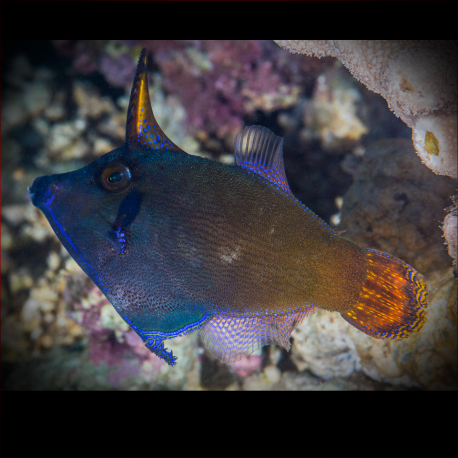More info
Datasheet
| Minimum Tank Size | 400 litres / 105.67 US gallons |
| Maximum Size | 13.0cm / 5.12inches |
| Reef Compatible | Reef safe with luck |
| Temperament | Might be aggressive towards similar species |
| Temperature | 22.2°C / 71.96°F - 25.6°C / 78.08°F |
| Specific Gravity | 1.020-1.025 |
| Carbonate Hardness | 8-12 |
| pH | 8.1-8.4 |
General Description
The Blackbar filefish, also known as the Ear-spot filefish, belongs to the Monacanthidae family. These fish have a distinct appearance that may not appeal to all aquarists. They are found in the Indo-Pacific region, ranging from East Africa to Samoa, and from southern Japan to New South Wales and Tonga. Filefish are known for occasionally preying on corals and invertebrates, making them less suitable for coral tanks.
Aquarium Suitability
The Blackbar filefish requires experience, preparation, and extra care in an aquarium environment. These fish are docile and shy, so caution is advised when housing them with more aggressive tank mates. They have specific dietary needs and may be challenging to feed sufficiently in captivity. Additionally, they prefer peace and quiet, both from the aquarist and other fish, during the acclimation process.
Demands, Care and Hardiness
With an average hardiness level, these filefish need good hiding spots, such as live rocks, in the aquarium. They should be fed several times a day, especially when first introduced. Once acclimated, they can feed on natural food sources within the aquarium, requiring less frequent feeding. The Blackbar filefish may become aggressive towards similar species, necessitating careful consideration when selecting tank mates.
Reef Suitability
Reef safe with luck, these fish can be compatible with reef environments. However, their tendency to eat small crustaceans and tubeworms poses a threat to certain invertebrates commonly found in reef tanks.
Aquarium Setup
To create a suitable environment for the Blackbar filefish, a tank of at least 400 liters is recommended. Maintaining water conditions with a pH ranging from 8.1 to 8.4, a specific gravity between 1.020 and 1.025, a temperature of 22.2-25.6°C, and a carbonate hardness of 8-12 dKH is crucial. Providing ample hiding places and ensuring peaceful surroundings are essential for their well-being.
Behaviour
These filefish are known to be fastidious eaters and may require diligent efforts to ensure they consume an adequate diet in captivity. Their shy and docile nature calls for a calm tank environment with minimal disturbances.
Feeding and Diet
The Blackbar filefish's diet should consist of macroalgae (e.g., seaweed or nori), microalgae (e.g., spirulina), and small crustaceans like krill, mysis, and artemia. Regular feeding multiple times a day is essential, especially during the initial adjustment period in the aquarium.
Habitat and Distribution
In the wild, Pervagor janthinosoma can be found in the East Indian Ocean, West Indian Ocean, Australia, Japan, Indonesia, East Pacific, and New Zealand. Their range extends from East Africa to Samoa in the east and southern Japan to New South Wales and Tonga in the south.

